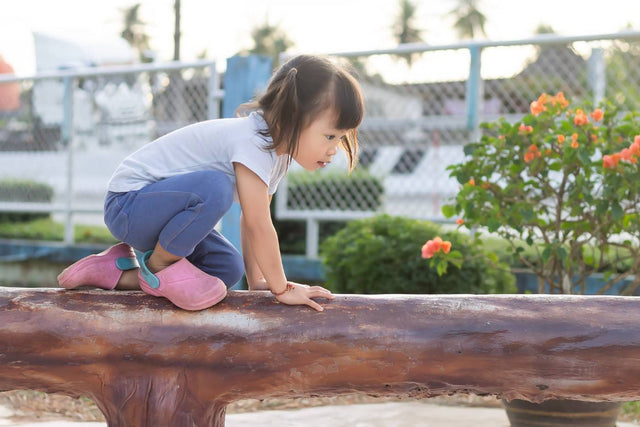30 Things to Say Instead of “Be Careful!”

Whether your kiddo is running full-steam down a steep hill, toting a giant found stick, climbing a tree, or roughhousing with their big sibling, the words “be careful” often come flying out of our mouths without a second thought. Shouting this phrase is, essentially, a parenting reflex. After all, no one wants their child to get hurt. But...how helpful is “be careful,” really?
When you think about it, “be careful” is so ubiquitous that it’s often reduced to background noise to kiddos. And it’s...vague. Be careful of what? Your toddler or preschooler is left wondering what, exactly, you want them to do. And perhaps worse, you could be sending the message that risk-taking is bad.
You may be thinking: But it is! (See “no one wants their child to get hurt,” above!) But if your tot does get injured, say, running up the slide or rolling around with their brother, the vast majority of resulting incidents are minor, studies suggest. And children who engage in so-called risky play become more independent, confident, resilient, and learn important self-regulation skills—more so than kiddos who remain in a proverbial bubble, according to research. All wonderful things!
Plus, if you want your tyke to learn how to manage and assess all kinds of risks down the road, they need exposure to some risky things. Does that mean willfully allowing your child to engage in super-dangerous activities, like riding a bike without a helmet? Heck, no! Instead, allow your child to try out some reasonable danger-teasing adventures while you guide them through it.
Here’s how to start:
-
Assess the actual risk. Instead of blindly tossing out warnings, it’s a better idea to assess each situation as it comes up and ask yourself, What’s the worst that could happen? A skinned knee or a bloody nose doesn’t really justify a full-stop warning.
-
Eliminate unnecessary risks. Allowing your child to experiment with healthy risk-taking is not the same thing as having a rule-free environment! It’s still your job to eliminate avoidable risks, like banning standing on the coffee table, wrestling close to stairs, or scootering without a helmet.
-
Give actual advice. “Be careful” is well-meaning but lacks specifics. If you’re worried that your child may get hurt, offer them tips on how to tune into their body and engage in their environment without getting injured...and ask pointed questions so they can figure it out themselves.
Alternatives to “Be Careful”
Try some of these phrases next time you feel a “be careful” bubbling up:
- Is there something for you to hold onto?
- Does that branch look strong?
- Take your time.
- Do you feel safe?
- What’s your exit strategy?
- Notice that the rocks are slippery.
- Keep an eye out for poison ivy.
- I’m right here if you need me.
- Stay focused on what you’re doing.
- Make sure you stick with your friends.
- Try using your hands to steady yourself.
- Watch for kids coming in the other direction.
- Does that feel stable or is it wiggly?
- If you feel the heat from the campfire, you’re too close.
- Are you scared?
- Remember that sticks are sharp.
- Is anyone behind you?
- What’s next?
- Before you throw that, what do you need to look out for?
- Ask before you rough-house!
- Move slowly and carefully near the water.
- What's your plan for crossing that log?
- Do you know how you’ll get up that structure?
- Is there anything that can help you do that safely?
- How will you get down?
- Try going down with your feet first.
- Test that out before your step on it.
- Give yourself enough space!
- Watch out for others; make sure everyone has space.
- Who will help you if you slip?